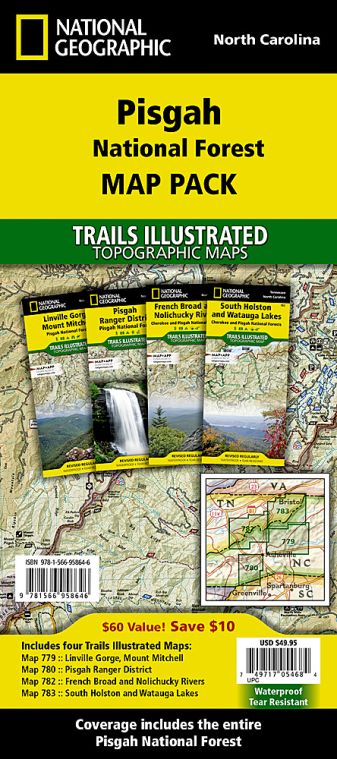The Pisgah National Forest encompasses 512,758 acres (801 sq mi, 2075 km2) of mountainous terrain in the southern Appalachian Mountains, including parts of the Great Balsam Mountains and the Blue Ridge Mountains.
The Pisgah National Forest is administered by the United States Forest Service and managed along with the North Carolina Forests. It is located in 12 counties in Western North Carolina: Transylvania, Haywood, Madison, Caldwell, Burke, McDowell, Yancey, Buncombe, Avery, Mitchell, Henderson, and Watauga counties. The National Forest is divided into three Ranger Districts:
- The Grandfather District
- Appalachian District
- Pisgah District
Where is Pisgah National Forest
Pisgah National Forest is a National Forest located entirely within North Carolina in the United States. It lies in the Appalachian Mountains of Western North Carolina.
Wilderness Areas
Pisgah National Forest has three officially three designated wilderness areas that are part of the National Wilderness Preservation System:
- Middle Prong Wilderness
- Linville Prong Wilderness
- Shining Rock Wilderness
Places to Visit Nearby
- Mount Mitchell State Park
- Blue ridge parkway
- North Carolina Arboretum
- French Broad River
- City of Asheville
- City of Brevard
- The Biltmore House
- Forest National Scenic Highway
- Sliding Rock Natural Water Slide
- Cradle of forestry
- Craggy Gardens
Things to Do
Tourists visiting Pisgah National Forest can indulge in diverse recreational activities. There are numerous Campgrounds and Picnic areas. Some of the popular activities are:
- Wildlife viewing and Bird watching
- Water activities (swimming, rafting, paddling, kayaking, Canoeing in Lake Powhatan Swim Area)
- Winter activities
- Scenic Drive
- Hiking and Mountain Biking
- Fishing
- Rock Climbing
- Ranger-led Programs
- Camping and backpacking
- Picnicking and Naturalist Tours
- Horseback Riding
Hiking
Pisgah National Forest has over 1700 miles of hiking trails. Various options are available, from a short hike, moderate to strenuous trek, backcountry adventures and trails, and multiple waterfalls and rivers. Some of the most marked hiking trails in the national park are:
- Graveyard Fields Trail: The 2.9 miles trail is the most popular and visited trek along the Blue Ridge Parkway. The track has some spectacular waterfalls along its route. One can spot Black Bears, and it is a great place to forage for blueberries.
- Catawba Falls Trail: The 3 miles trail (round trip) is located in the southeastern reaches of the Blue Ridge Mountains. It is one of the most significant waterfall hikes of the Pisgah National Forest, with easy access from I-40 via the old fort.
- Mount Mitchell Trail: The trail is 11.3 miles (round-trip), with the trailhead located at the Black Mountain Campground. Mountains. It is a strenuous trail recommended for experienced hikers at the elevation of 6914 feet, as the summit of Mount Mitchell is the tallest in North Carolina.
- Moore Cove Falls Trail: The trail is 1.2 miles easy, family-friendly hike. The course attracts crowds due to its accessibility and well-established paths that lead through fern-laden woodlands and has bridges for all creek crossings.
Facts
- In 1916, Pisgah National Forest was established and was one of the first national forests in the Eastern United States.
- Pisgah National Forest includes some of the highest mountains in the eastern United States, and elevations reach over 6,000 feet (1,800).
- The mountain tops (Summits) in the Pisgah National Fores include Black Balsam Bald at 6,214 feet(1,894 m), Tenant Mountain at 6,056 feet (1,846 m), Mount Hardy at 6,110 feet (1,860 m), and Cold Mountain at 6,030 feet (1,840 m).
- Pisgah National Forest has about 46,600 acres (189 km2) of old-growth forest, of which 10,00 acres (4000 ha) are in Linville Gorge.
Best Time to Visit
Pisgah National Forest is a four-season recreation experience. The best time to see Pisgah National forest is September through November, and October is the busiest month. Tourists visit this time for Fall foliage and its vibrant colours. Other great times to see Pisgah National forest are the winter months from December to February, to indulge in winter sports.
Ticket Prices
Pisgah National Forest is open year-round, 24 hours a day except on national holidays, and one does not require any fees or permits to enter the forest. Recreation fees and forest permits are required to enter the national forest areas and engage in recreational activities to improve the amenities. The recreation fees vary by type and size. The annual Interagency passes are:
- America the Beautiful-National Parks & Federal Recreational Lands Annual Pass: $80
- Annual Forest and Interagency Pass: $55
US National Parks Map

